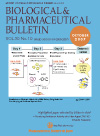Volume 25, Issue 9
Displaying 1-32 of 32 articles from this issue
- |<
- <
- 1
- >
- >|
Analytical Biochemistry
Regular Articles
-
Article type: Regular Article
Subject area: Analytical Biochemistry
2002Volume 25Issue 9 Pages 1121-1124
Published: 2002
Released on J-STAGE: September 01, 2002
Download PDF (71K)
Biochemistry/Molecular Biology
Regular Articles
-
Article type: Regular Article
Subject area: Biochemistry/Molecular Biology
2002Volume 25Issue 9 Pages 1125-1128
Published: 2002
Released on J-STAGE: September 01, 2002
Download PDF (88K) -
Article type: Regular Article
Subject area: Biochemistry/Molecular Biology
2002Volume 25Issue 9 Pages 1129-1132
Published: 2002
Released on J-STAGE: September 01, 2002
Download PDF (63K)
Notes
-
Article type: Note
Subject area: Biochemistry/Molecular Biology
2002Volume 25Issue 9 Pages 1209-1211
Published: 2002
Released on J-STAGE: September 01, 2002
Download PDF (40K) -
Article type: Note
Subject area: Biochemistry/Molecular Biology
2002Volume 25Issue 9 Pages 1212-1213
Published: 2002
Released on J-STAGE: September 01, 2002
Download PDF (37K) -
Article type: Note
Subject area: Biochemistry/Molecular Biology
2002Volume 25Issue 9 Pages 1214-1216
Published: 2002
Released on J-STAGE: September 01, 2002
Download PDF (57K) -
Article type: Note
Subject area: Biochemistry/Molecular Biology
2002Volume 25Issue 9 Pages 1217-1219
Published: 2002
Released on J-STAGE: September 01, 2002
Download PDF (62K) -
Article type: Note
Subject area: Biochemistry/Molecular Biology
2002Volume 25Issue 9 Pages 1220-1222
Published: 2002
Released on J-STAGE: September 01, 2002
Download PDF (56K)
Pharmacology
Regular Articles
-
Article type: Regular Article
Subject area: Pharmacology
2002Volume 25Issue 9 Pages 1133-1136
Published: 2002
Released on J-STAGE: September 01, 2002
Download PDF (74K) -
Article type: Regular Article
Subject area: Pharmacology
2002Volume 25Issue 9 Pages 1137-1141
Published: 2002
Released on J-STAGE: September 01, 2002
Download PDF (90K) -
Article type: Regular Article
Subject area: Pharmacology
2002Volume 25Issue 9 Pages 1142-1146
Published: 2002
Released on J-STAGE: September 01, 2002
Download PDF (83K) -
Article type: Regular Article
Subject area: Pharmacology
2002Volume 25Issue 9 Pages 1147-1150
Published: 2002
Released on J-STAGE: September 01, 2002
Download PDF (52K) -
Article type: Regular Article
Subject area: Pharmacology
2002Volume 25Issue 9 Pages 1151-1155
Published: 2002
Released on J-STAGE: September 01, 2002
Download PDF (57K) -
Article type: Regular Article
Subject area: Pharmacology
2002Volume 25Issue 9 Pages 1156-1160
Published: 2002
Released on J-STAGE: September 01, 2002
Download PDF (60K)
Notes
-
Article type: Note
Subject area: Pharmacology
2002Volume 25Issue 9 Pages 1223-1227
Published: 2002
Released on J-STAGE: September 01, 2002
Download PDF (303K) -
Article type: Note
Subject area: Pharmacology
2002Volume 25Issue 9 Pages 1228-1230
Published: 2002
Released on J-STAGE: September 01, 2002
Download PDF (64K)
Toxicology
Regular Articles
-
Article type: Regular Article
Subject area: Toxicology
2002Volume 25Issue 9 Pages 1161-1164
Published: 2002
Released on J-STAGE: September 01, 2002
Download PDF (48K) -
Article type: Regular Article
Subject area: Toxicology
2002Volume 25Issue 9 Pages 1165-1168
Published: 2002
Released on J-STAGE: September 01, 2002
Download PDF (109K)
Notes
-
Article type: Note
Subject area: Toxicology
2002Volume 25Issue 9 Pages 1231-1233
Published: 2002
Released on J-STAGE: September 01, 2002
Download PDF (53K)
Pharmacognosy
Regular Articles
-
Article type: Regular Article
Subject area: Pharmacognosy
2002Volume 25Issue 9 Pages 1169-1174
Published: 2002
Released on J-STAGE: September 01, 2002
Download PDF (89K) -
Article type: Regular Article
Subject area: Pharmacognosy
2002Volume 25Issue 9 Pages 1175-1178
Published: 2002
Released on J-STAGE: September 01, 2002
Download PDF (59K) -
Article type: Regular Article
Subject area: Pharmacognosy
2002Volume 25Issue 9 Pages 1179-1182
Published: 2002
Released on J-STAGE: September 01, 2002
Download PDF (57K) -
Article type: Regular Article
Subject area: Pharmacognosy
2002Volume 25Issue 9 Pages 1183-1187
Published: 2002
Released on J-STAGE: September 01, 2002
Download PDF (60K) -
Article type: Regular Article
Subject area: Pharmacognosy
2002Volume 25Issue 9 Pages 1188-1191
Published: 2002
Released on J-STAGE: September 01, 2002
Download PDF (55K)
Notes
-
Article type: Note
Subject area: Pharmacognosy
2002Volume 25Issue 9 Pages 1234-1237
Published: 2002
Released on J-STAGE: September 01, 2002
Download PDF (79K) -
Article type: Note
Subject area: Pharmacognosy
2002Volume 25Issue 9 Pages 1238-1240
Published: 2002
Released on J-STAGE: September 01, 2002
Download PDF (46K) -
Article type: Note
Subject area: Pharmacognosy
2002Volume 25Issue 9 Pages 1241-1243
Published: 2002
Released on J-STAGE: September 01, 2002
Download PDF (48K)
Biopharmacy
Regular Articles
-
Article type: Regular Article
Subject area: Biopharmacy
2002Volume 25Issue 9 Pages 1192-1196
Published: 2002
Released on J-STAGE: September 01, 2002
Download PDF (57K) -
Article type: Regular Article
Subject area: Biopharmacy
2002Volume 25Issue 9 Pages 1197-1202
Published: 2002
Released on J-STAGE: September 01, 2002
Download PDF (83K)
Miscellaneous
Regular Articles
-
Article type: Regular Article
Subject area: Miscellaneous
2002Volume 25Issue 9 Pages 1203-1208
Published: 2002
Released on J-STAGE: September 01, 2002
Download PDF (84K)
Communications to the Editor
-
Article type: Communication
Subject area: [not specified]
2002Volume 25Issue 9 Pages 1244-1246
Published: 2002
Released on J-STAGE: September 01, 2002
Download PDF (46K) -
Article type: Communication
Subject area: [not specified]
2002Volume 25Issue 9 Pages 1247-1249
Published: 2002
Released on J-STAGE: September 01, 2002
Download PDF (45K)
- |<
- <
- 1
- >
- >|
